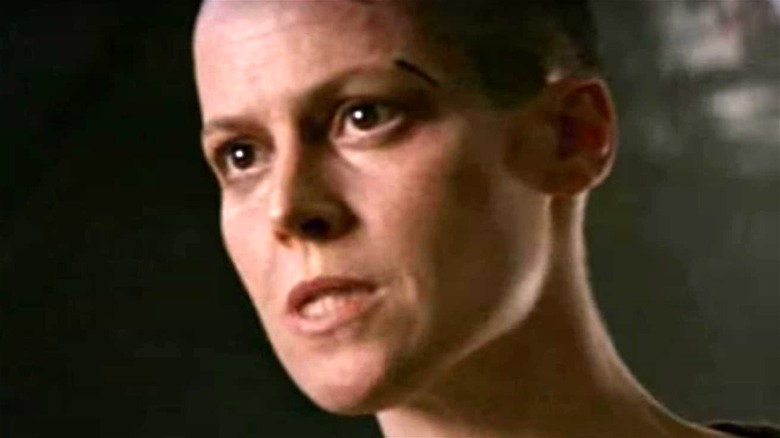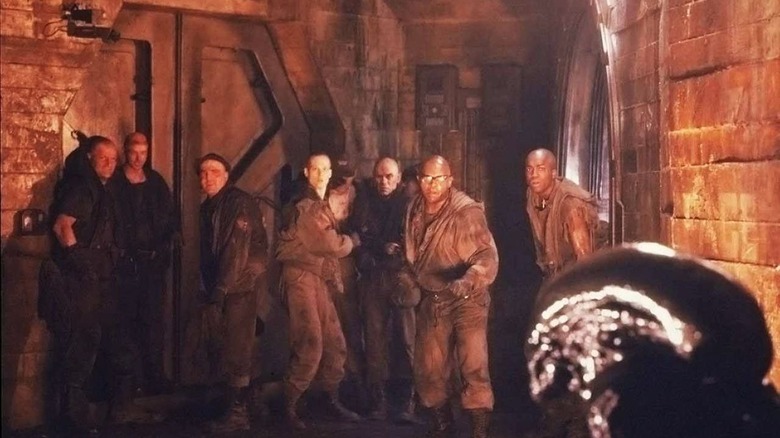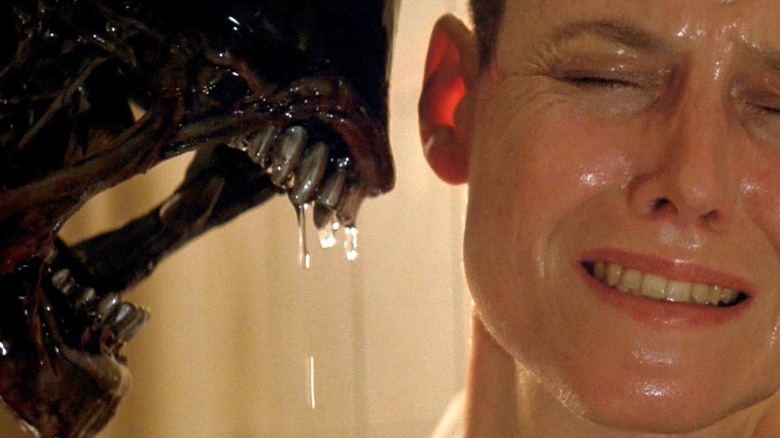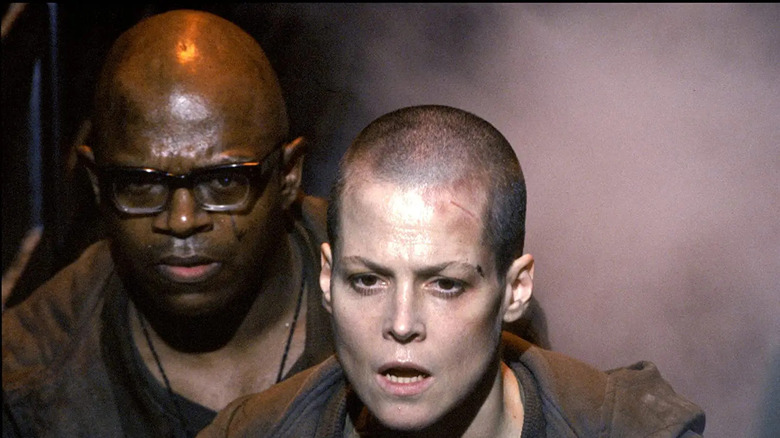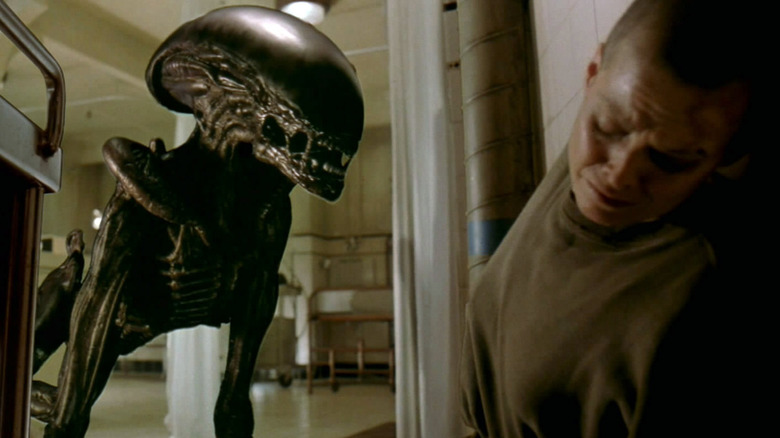Why Alien 3 Almost Never Got Released
In 1979, filmmaker Ridley Scott released one of two science fiction films he crafted which helped completely reshape the genre: "Alien." The film perfectly straddled 1970s auteur filmmaking with the recently-birthed era of blockbusters. Yes, it was set in space like "Star Wars," and there was an element of "Jaws" within the basics of the storytelling, but it was also a film about isolation, the dangers of corporatocracy, and the even greater dangers of not taking care to avoid contamination.
In short, "Alien" was a massive success in the moment, (earning $106 million from an $11 million budget), and it also continues to be one of the most influential and relevant works of science fiction ever made. Similarly, filmmaker James Cameron released two genre redefining sci-fi films in the 1980s, one being the long-awaited "Alien" sequel "Aliens." Where "Alien" played into existential dread, "Aliens" felt more like a war movie where fighting the alien other was a matter of kill or be killed.
Just as with Ridley Scott, James Cameron also found massive success with the "Alien" franchise bringing in $131 million at the box office. At this point, you would think a third "Alien" would be a sure thing — and it was. However, the story of "Alien 3" is one so rife with challenges that the film almost never saw release.
Alien 3 was originally going to be Alien 3 and 4
The phrase "too big to fail" is often ironically ascribed to something whose size is the exact reason for its ultimate failing — and the "Alien" franchise could absolutely be described as too big too fail after its second outing. Complications, however, were already brewing. For example, lead actor Sigourney Weaver, whose role as Ellen Ripley is so core to the franchise, was frustrated with scenes cut from "Aliens" which explained that she'd lost a daughter and thus informed the bond she forms with Newt (Carrie Henn).
There are always ways to work around talent, and that's precisely part of where the journey toward "Alien 3" begins. 20th Century Fox approached the production company responsible for the "Alien" franchise thus far, Brandywine Productions, about a third entry. The concept for the film was basically Weyland-Yutani Corp. versus socialism. Rather than one movie, the third story was to be split into two with the first focuses not on Ellen Ripley but on Corporal Hicks (Michael Biehn) from "Aliens," according to the "Wreckage and Rage: The Making of Alien 3," seen on the "Alien" Quadrilogy box set.
Speaking of too big to fail, the decision was made to bring in novelist (and cyberpunk legend) William Gibson to pen the script with the (brief) hope that Ridley Scott would also return for directing duties (he was unavailable). It's hard to overstate what a magnum opus this project sounds like it should be, based purely on the concepts and the players involved — but then things started to fall apart.
William Gibson and big problems in Mallworld
The first sign of trouble was something existing completely outside of Brandywine Production's control: an impending WGA strike which occurred in early 1988. The arguably logical decision was to ask William Gibson to turn around his script in three months time. Remember, this was a script which had to do the following: be tonally different than the first two films, transform Corporal Hicks into the story's protagonist, and establish a kind of cold way between Weyland-Yutani and a socialist civilization — also, the xenomorphs still had to be a big part of the story because this is still the "Alien" franchise.
Gibson did as he was asked, but the result was not satisfactory to anyone involved. The studio wanted rewrites, but Gibson declined. While the long arm of history has come to view that initial script positively (there are comics, audio plays and novelizations based on it), at the time, the script was jettisoned like the queen at the end of "Aliens."
We wish we could say that Gibson's departure signaled a pivot point where things with "Alien 3" immediately got better, but the struggles kept coming.
Prison planets, monks, and the return of Ellen Ripley
There were multiple scripts in play after Gibson departed the project. The first, still operating under the original concept pushed by Walter Hill and David Giler of Brandywine Productions, was crafted by writer of "The Hitcher" Eric Red. The idea of bringing on a horror writer might have seemed appealing, especially one who could work to both budget and deadline, but the result was so unsatisfactory that Red himself referred to his work as "the one script I completely disown because it was not 'my script.'" Both Red and his script were dropped, along with the concept of two films.
There's one other player we have not discussed yet: the film's initial director. Rather than Ridley Scott, Renny Harlin was brought in after the success of his work on "A Nightmare on Elm Street 4: The Dream Master." Throughout the complications with scripts, Harlin remained on board the project up until this point — that, however, was about to change.
David Twohy (who had already successfully crafted the sequel to "Critters") was the writer who both came aboard next and also introduced the setting of a prison planet. It was also around this time that an agreement was made to place Ellen Ripley back as the focal point of the story.
However, somewhat simultaneously, a new director, Vincent Ward, was hired. Together with writer John Fasano, another script about monks on an all-wooden monastery was crafted. Once Twohy caught wind of a competing script, he ditched the project. Shortly thereafter, Ward's team also left the project when it was decided that his all-wooden set design idea was too much style over substance.
David Fincher's no good, very bad day
By this point, some of the foundational building blocks for "Alien 3" were coming into focus, bringing it the closest it had been thus far to reality.
There were scripts and elements written by the likes of Larry Ferguson (whose name appears in the final credits) and Rex Pickett (whose name does not) but ultimately it was Walter Hill and David Giler who, at the behest of Sigourney Weaver herself, took the best ideas from all previous scripts and slowly transformed them into the final script.
The final director was found in the form of frequent music video director David Fincher. Fincher had his own challenges during a production. In an interview at BFI Southbank, he said of the project, "I had to work on it for two years, got fired off it three times and I had to fight for every single thing. No one hated it more than me; to this day, no one hates it more than me."
"On that movie, I was the guy who was constantly the voice of 'We need to do this better, we need to do this, this doesn't make sense,'" Fincher explained of his struggles. "And pretty soon, it was like in Peanuts: WOP WOP WOP WOP WOP! They'd go, 'He's doing that again, he's frothing at the mouth, he seems so passionate.' They didn't care."
The runner alien and a surprisingly successful film
The production of "Alien 3" had problems beyond directorial conflict, not least of which begin with the fact that the script wasn't even completed by the time production began in early January 1991. Tragically, Jordan Cronenweth, who was set to be the cinematographer, left the project only two weeks in when he began to suffer the side effects of Parkinson's disease.
And then there are the effects, especially that of the xenomorph alien itself. Whereas the previous incarnations were far more bipedal and humanoid in design, "Alien 3" has the "runner" or "dog" alien. This required actors, rod-puppets, rotoscoping, and a motion control camera. Not only were there challenges in some cases of removing puppeteers from shots, but there was also an unsuccessful desire on Fincher's part to have Whippet dressed as the alien for certain shots. Bringing the runner alien to life was far from a simple process.
However, despite complexities and the fact that it could very easily have never made its way to theaters, "Alien 3" was released on May 22, 1992 earning nearly $160 million from a $50 million budget, technically making it more successful than the previous two films and eventually leading to a fourth film, "Alien: Resurrection."
